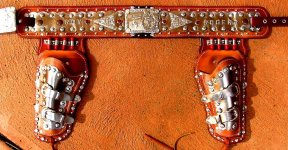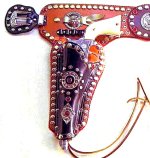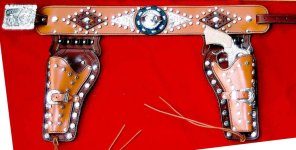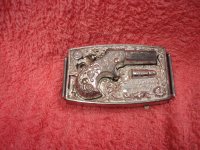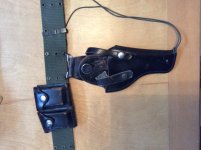rednichols
Member
After a pleasant (for me anyway) vacation over to the defensive carry subforum here, I'm back to offer more dry holstory.
The modern holster industry owes everything to the companies that replaced Heiser in the 1960s. Heiser was a mail order company, whilst Bianchi and Safariland promulgated the stocking dealer. This was a sea change. And John used to say that his opportunity to break into the industry was a once-in-a-lifetime opportunity that would not be repeated for others.
But how did this come to be, when Heiser had been prosperous since 1858? It was not because of Hermann's death at the turn of the 20th century by any means: it was his sons, and the Model T, that built a saddlery into a holster company to be reckoned with.
As the bits come together a likely scenario appears mighty plausible, through tracking the appearances of newspaper articles of the company's era and its catalogues -- and its many moves around the city of Denver.
There were four Heiser sons. The youngest died the year before Hermann and played no part in the rise of the House of Heiser. Son Ewald became the head of the saddlery whilst the other two sons focused on automobiles and banking, I believe.
So it was a young Ewald who was the man who mattered. I would say that later, the company moved at least once in support of WWII, and the end of the war and Ewald's age led the company to be acquired by The Denver Dry Goods, a huge retailer that by the early 1960s had itself been sold for $20 million. DDG for no obvious reason, acquired Heiser though it already owned its own saddlery in Denver called Powder River; and Ewald stayed on to manage it. I expect not a lot of money changed hands.
DDG "released its interest" in Heiser in 1950 after selling the Heiser building, both likely because Ewald had been killed in an auto accident in 1949 and DDG was a retailer. My view is that phrase was not about 'selling' the company; Keyston Bros did not merge with Heiser for five more years. More likely is that DDG simply let it go back to the remaining two Heiser brothers John and Arthur, once it became an albatross for DDG.
In the 1950s Keyston Bros. was huge in what were called then "junior cowboy and cowgirl capgun sets". Interestingly to me, the capguns themselves were accessories; it was the leather sets that Keyston made that were the 'value added', and today they are mighty collectible and bring higher prices than Heisers. This one is a restoration:
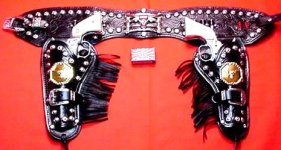
I have yet to sight any Heiser catalogues past No. 42, which is 1949 or so, until No. 50 appeared. It seems to me that the two brothers trundled along with that single catalogue until, in 1955, Keyston 'merged' with Heiser; that is, perhaps simply took it over, so that they could continue to empire build by adding capacity for capgun sets. Catalogue No. 50 appeared and is calculated to be 1957, at which point with it and No. 51 there was rather odd experimentation with adding to the model numbers prefixes, then changing to suffixes, then by No. 52 dispensing with both!
By 1960 they had acquired another saddlery, Lichtenberger-Ferguson; or so legend has it, because A.J. Keyston already owned the company by the mid-1940s. The company became first Heiser-Keyston (the sequence of names I suggest was for credibility) then Heiser-Keyston-Lichtenberger. Perhaps Lichtenberger, which dated from the beginning of the century, was for more capgun holster capacity.
But two things happened around 1960: John (actually Johanne) Heiser died, too, in 1961; and the appearance of Dr. No in 1962 spelt the end of junior cowboy holster sets. I'm aware of HKL catalogues only up until 1960 and thereafter the brand appears to have simply faded away.
Enter John Bianchi with his efforts beginning 1963 and evolving into Bianchi Holster in 1966, which was his first full-time effort at a holster company. Perkins' Safariland split off in '65 and the two companies stormed the market place in the absence of Heiser (Keyston itself is still in business as an automotive supplier) and using the new 'stocking dealer' model that in the 1970s was either copied successfully by the other players, or else their companies faded away.
Which is a story for another day.
The modern holster industry owes everything to the companies that replaced Heiser in the 1960s. Heiser was a mail order company, whilst Bianchi and Safariland promulgated the stocking dealer. This was a sea change. And John used to say that his opportunity to break into the industry was a once-in-a-lifetime opportunity that would not be repeated for others.
But how did this come to be, when Heiser had been prosperous since 1858? It was not because of Hermann's death at the turn of the 20th century by any means: it was his sons, and the Model T, that built a saddlery into a holster company to be reckoned with.
As the bits come together a likely scenario appears mighty plausible, through tracking the appearances of newspaper articles of the company's era and its catalogues -- and its many moves around the city of Denver.
There were four Heiser sons. The youngest died the year before Hermann and played no part in the rise of the House of Heiser. Son Ewald became the head of the saddlery whilst the other two sons focused on automobiles and banking, I believe.
So it was a young Ewald who was the man who mattered. I would say that later, the company moved at least once in support of WWII, and the end of the war and Ewald's age led the company to be acquired by The Denver Dry Goods, a huge retailer that by the early 1960s had itself been sold for $20 million. DDG for no obvious reason, acquired Heiser though it already owned its own saddlery in Denver called Powder River; and Ewald stayed on to manage it. I expect not a lot of money changed hands.
DDG "released its interest" in Heiser in 1950 after selling the Heiser building, both likely because Ewald had been killed in an auto accident in 1949 and DDG was a retailer. My view is that phrase was not about 'selling' the company; Keyston Bros did not merge with Heiser for five more years. More likely is that DDG simply let it go back to the remaining two Heiser brothers John and Arthur, once it became an albatross for DDG.
In the 1950s Keyston Bros. was huge in what were called then "junior cowboy and cowgirl capgun sets". Interestingly to me, the capguns themselves were accessories; it was the leather sets that Keyston made that were the 'value added', and today they are mighty collectible and bring higher prices than Heisers. This one is a restoration:

I have yet to sight any Heiser catalogues past No. 42, which is 1949 or so, until No. 50 appeared. It seems to me that the two brothers trundled along with that single catalogue until, in 1955, Keyston 'merged' with Heiser; that is, perhaps simply took it over, so that they could continue to empire build by adding capacity for capgun sets. Catalogue No. 50 appeared and is calculated to be 1957, at which point with it and No. 51 there was rather odd experimentation with adding to the model numbers prefixes, then changing to suffixes, then by No. 52 dispensing with both!
By 1960 they had acquired another saddlery, Lichtenberger-Ferguson; or so legend has it, because A.J. Keyston already owned the company by the mid-1940s. The company became first Heiser-Keyston (the sequence of names I suggest was for credibility) then Heiser-Keyston-Lichtenberger. Perhaps Lichtenberger, which dated from the beginning of the century, was for more capgun holster capacity.
But two things happened around 1960: John (actually Johanne) Heiser died, too, in 1961; and the appearance of Dr. No in 1962 spelt the end of junior cowboy holster sets. I'm aware of HKL catalogues only up until 1960 and thereafter the brand appears to have simply faded away.
Enter John Bianchi with his efforts beginning 1963 and evolving into Bianchi Holster in 1966, which was his first full-time effort at a holster company. Perkins' Safariland split off in '65 and the two companies stormed the market place in the absence of Heiser (Keyston itself is still in business as an automotive supplier) and using the new 'stocking dealer' model that in the 1970s was either copied successfully by the other players, or else their companies faded away.
Which is a story for another day.
Last edited:



